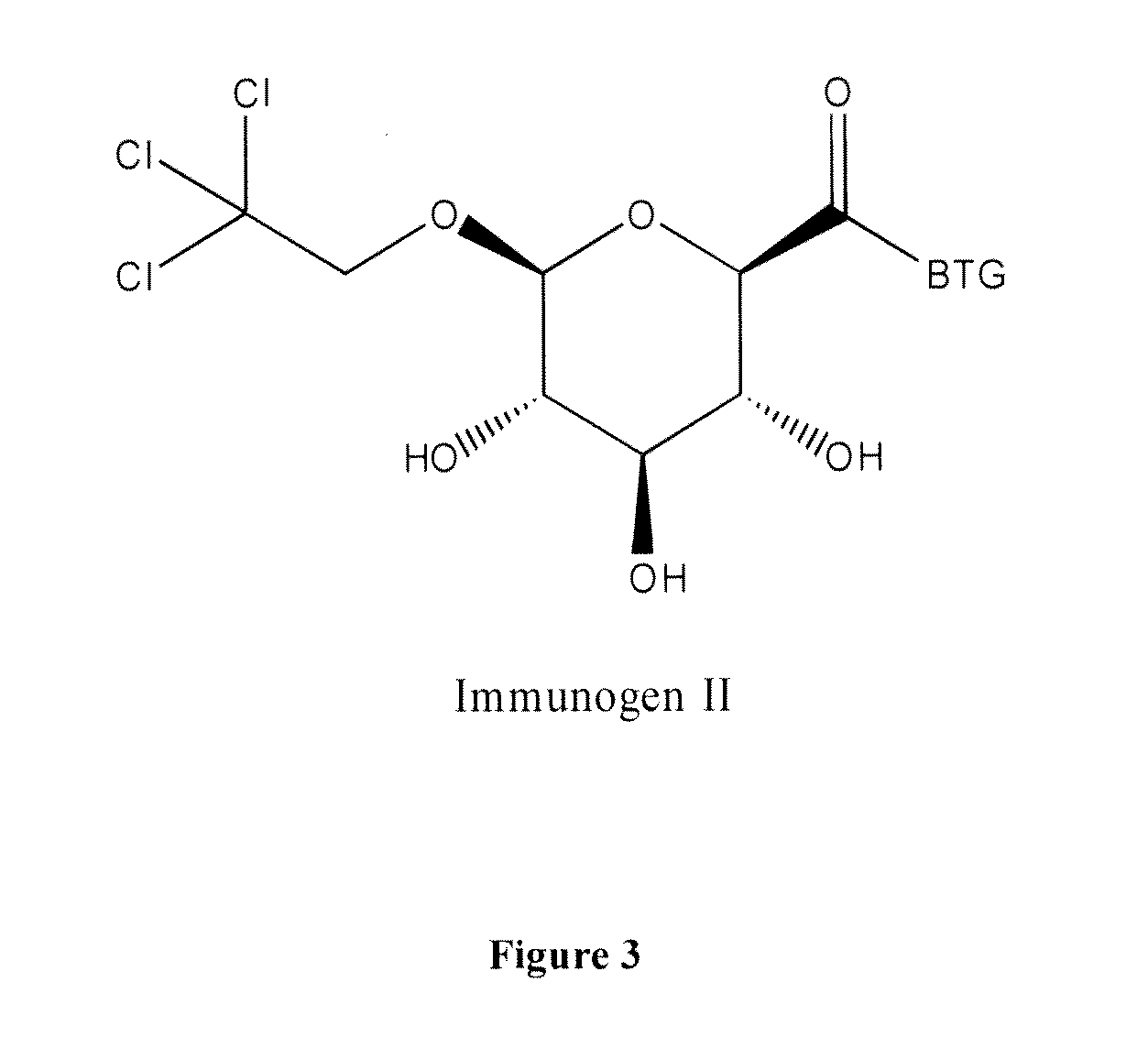Chloral Hydrate Detection
a chloral hydrate and detection method technology, applied in the field of chloral hydrate detection, can solve the problems of limited use, general lack of definitive proof of chloral hydrate use in dfr, and restricted field-based methods, and achieve the effect of rapid metabolism of chloral hydra
- Summary
- Abstract
- Description
- Claims
- Application Information
AI Technical Summary
Benefits of technology
Problems solved by technology
Method used
Image
Examples
example 1
Preparation of 1-O-trichloroethyl-2,3,4-tri-O-acetyl-α-D-glucopyranuronic acid methyl ester 1
Method A
[0038]To a solution of acetobromo-α-D-glucuronic acid methyl ester (5.96 g, 0.015 mol) in anhydrous benzene (200 ml) was added Silver carbonate (4.14 g, 0.015 mol) and 2,2,2-trichloroethanol (142 ml). The mixture was then heated at reflux for 4 hours and cooled at room temperature. The reaction was filtered and the filtrate was concentrated to dryness. The residue obtained was purified by chromatography on silica gel using a mixture of hexane-ethyl acetate (7 / 3)(v / v) to give acetobromo-α-D-glucuronic acid methyl ester (3.0 g) and the 1-O-trichloroethyl-2,3,4-tri-O-acetyl-α-D-glucopyranuronic acid methyl ester 1 (1.5 g) as a white powder solid
Method B
[0039]BF3-Et2O (15 ml) was added dropwise to a cooled solution at 0° C. of 1,2,3,4-tetra-O-acetyl-β-D-glucopyranuronic acid methyl ester (11.23 g, 0.03 mol) and 2,2,2-trichloroethanol (20 ml) in anhydrous dichloromethane (250 ml) under in...
example 2
Preparation of Trichloroethyl Glucuronide (Hapten A)
[0040]To a solution of 1-O-trichloroethyl-2,3,4-tri-O-acetyl-α-D-glucopyranuronic acid methyl ester 1 (5 g, 10.7 mM) in a mixture of methanol (90 ml) and water (10 ml) was added at 0° C. solid Lithium hydroxide (2.25 g, 53.7 mM) and the mixture was stirred at room temperature overnight. TLC indicated reaction to be completed. The methanol was removed under vacuum, water (100 ml) was added, the mixture was then neutralised to pH 7 by a solution of HCl (1N). The solution was evaporated to dryness and the solid obtained was suspended in methanol / chloroform (1:4) and stirred for seven hours at room temperature. The insoluble salts were removed by filtration and the solution was evaporated to dryness to give Hapten A (3.1 g) as a white solid.
example 3
Preparation of Trichloroethyl Glucuronide Homocysteine Thiolactone (Hapten B)
[0041]To a solution under nitrogen of TCG (Hapten A) (1.25 g, 3.83 mM) in dry pyridine (25 ml) was added homocysteine thiolactone hydrochloride (590 mg, 3.84 mM) and EDC hydrochloride (885 mg, 4.6 mM) and the mixture was stirred overnight at room temperature. Pyridine was removed under vacuum and the residue obtained purified by flash chromatography on silica gel using 20% methanol / 80% chloroform to afford 750 mg of the pure trichloroethyl glucuronide homocysteine thiolactone (Hapten B) as an off-white foamy solid.
PUM
| Property | Measurement | Unit |
|---|---|---|
| pH | aaaaa | aaaaa |
| pH | aaaaa | aaaaa |
| pH | aaaaa | aaaaa |
Abstract
Description
Claims
Application Information
 Login to View More
Login to View More - R&D
- Intellectual Property
- Life Sciences
- Materials
- Tech Scout
- Unparalleled Data Quality
- Higher Quality Content
- 60% Fewer Hallucinations
Browse by: Latest US Patents, China's latest patents, Technical Efficacy Thesaurus, Application Domain, Technology Topic, Popular Technical Reports.
© 2025 PatSnap. All rights reserved.Legal|Privacy policy|Modern Slavery Act Transparency Statement|Sitemap|About US| Contact US: help@patsnap.com



